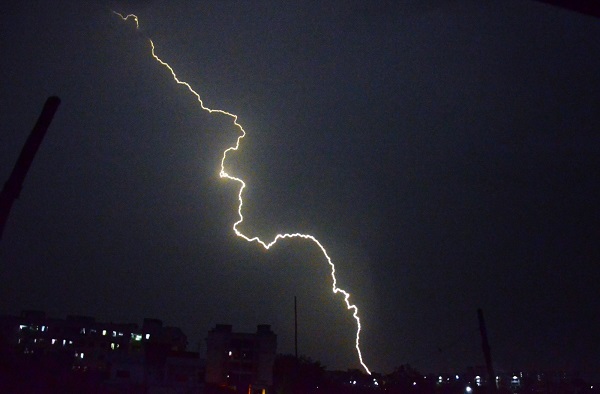New Delhi, (Samajweekly) An analysis of lightning activity over two regions in India — arid and humid — has shown that presence of aerosols that influences cloud micro-physics leads to increased instances of lightning over the humid region compared to the arid region.
The association between aerosol and lightning was investigated with long-term decadal data (2005-2014) for lightning, aerosol optical depth (AOD), relative humidity, and effective cloud droplet size as part of the study ‘Lightning Characteristics Over Humid Regions and Arid Regions and Their Association With Aerosols Over Northern India.’
Aerosol is a suspension of fine solid particles or liquid droplets in air or another gas and can be natural or anthropogenic.
The study considered two different regions with different climatic and weather conditions to understand the complex relationship between aerosol and lightning: a humid region R1 (22 degrees – 29 degrees N, 89 degrees – 92 degrees E, pertaining to parts of the West Bengal, Assam, Meghalaya and Tripura, and Bangladesh) and an arid region R2 (23 degrees – 28 degrees N, 70 degrees – 76 degrees E pertaining to Rajasthan).
The results show that lightning activity was observed to occur more over the humid region R1 for 1,141 days (1/3 of total days), than over the arid region R2, for 740 days (1/5 of total days), the study — published in journal ‘Pure and Applied Geophysics’, said.
The authors S.P. Jnanesh, D.M. Lal, V. Gopalkrishnan, Sachin Ghude, Sunil D Pawar and S Tiwari are all from Indian Institute of Tropical Meteorology (IITM), Pune and Manoj K Srivastava is from Department of Geophysics, Banaras Hindu University (BHU), Varanasi.
The study also established that for different AOD values, the flash intensity varied for both R1 and R2.
“The analysis shows that a nonlinear relationship exists between aerosol and lightning with a highly associated influence of relative humidity. A very significant positive and negative correlation that varies with relative humidity has been observed between AOD and lightning for both humid and arid regions. This shows relative humidity is the key factor in determining the increase or decrease of lightning activity,” the researchers said.
Stating that the atmospheric humidity is the driving factor in deciding the positive or negative co-relationship between aerosol and lightning, the study also showed that the larger the cloud droplet size, the higher the relative humidity and vice versa.
The study emphasized that aerosol concentration in the atmosphere influences cloud micro-physics by modulating the size of cloud droplets and thereby regulating the lightning frequency.










